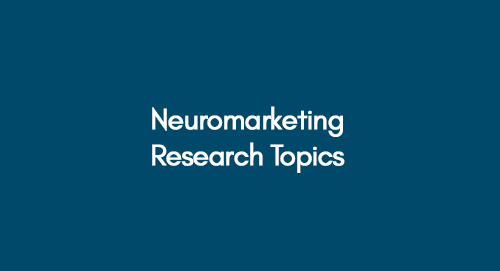
The Significance of Third-Person Writing | A Guide on Its Implementation
November 16, 2022
List of Top 120+ Digital Marketing Dissertation Topics in 2025
November 16, 2022Neuromarketing is an application of neuroscience and cognitive science that revolves around the relationship between human ‘nerves’ and ‘marketing’. Neuromarketing studies decision-making behaviour for marketing purposes by monitoring brainwave activity. Research in neuromarketing is among the leading academic studies. Thus, students must look for appealing and extraordinary neuromarketing research topics.
Marketing Dissertation Examples
Premier Dissertations has produced a list of new dissertation topics in neuromarketing for 2025.
Digital Marketing Dissertation Topics | Fashion Marketing Dissertation Topics
List of Latest Neuromarketing Dissertation Topics 2025
Trending Research Topics in Neuromarketing
Top Quality Thesis Topics in Neuromarketing
Quality Neuromarketing Research Topics for Undergraduate Students in 2025
Topic 16. Analysing the Role of Eye-Tracking Technology in Understanding Consumer Attention to Digital Advertisements in the UK: A Case Study
Topic 17. Examining the Impact of Emotional Appeals in Neuromarketing Campaigns on UK Consumer Buying Behaviour: A Systematic Study
Topic 18. Understanding the Influence of Colour Psychology on Brand Perception in the UK: A Qualitative Study
Topic 19. Assessing the Effectiveness of Neuromarketing Techniques in Optimising Product Packaging for UK Consumers: A Quantitative Study
Topic 20. Evaluating the Role of Brain Imaging in Predicting UK Consumer Preferences for Luxury Products: A Case Study
Topic 21. Analysing the Use of EEG Technology in Measuring Emotional Responses to Advertising in the UK: A Systematic Study
Topic 22. Examining the Effectiveness of Scent Marketing in Enhancing Brand Loyalty in UK Retail Environments: A Qualitative Study
Topic 23. Understanding the Role of Music Tempo in Influencing Shopping Behaviour in UK Supermarkets: A Quantitative Study
Topic 24. Assessing the Impact of Predictive Analytics in Neuromarketing on Consumer Decision-Making in the UK: A Case Study
Topic 25. Evaluating the Role of Emotional Branding in Enhancing UK Consumer Engagement Through Neuromarketing: A Systematic Study
Topic 26. Analysing the Influence of Subliminal Messaging in Shaping UK Consumer Choices: A Qualitative Study
Topic 27. Examining the Role of Cognitive Load in Designing Effective Digital Advertisements in the UK: A Quantitative Study
Topic 28. Understanding the Effectiveness of Storytelling Techniques in Neuromarketing for UK Nonprofit Campaigns: A Case Study
Topic 29. Assessing the Role of Neuromarketing in Predicting the Success of New Product Launches in the UK: A Systematic Study
Topic 30. Evaluating the Impact of Neuromarketing on the Design of E-Commerce Websites in the UK: A Qualitative Study
Topic 31. Analysing the Use of Facial Expression Analysis in Understanding UK Consumer Reactions to Advertising: A Quantitative Study
Topic 32. Examining the Effect of Visual Complexity in Advertisements on Consumer Engagement in the UK: A Systematic Study
Topic 33. Understanding the Role of Mirror Neurons in Enhancing Consumer Identification with UK Brands: A Case Study
Topic 34. Assessing the Influence of Personalised Advertising on UK Consumer Trust Using Neuromarketing Metrics: A Qualitative Study
Topic 35. Evaluating the Effectiveness of Multisensory Marketing Campaigns in the UK Fashion Industry: A Quantitative Study
Topic 36. Analysing the Role of Neuromarketing in Enhancing the Shopping Experience for UK Online Grocery Retail: A Case Study
Topic 37. Examining the Impact of Neuromarketing on UK Consumer Behaviour During Sales Events: A Systematic Study
Topic 38. Understanding the Role of Emotional Triggers in Increasing Advertisement Recall Among UK Millennials: A Qualitative Study
Topic 39. Assessing the Potential of Neuro-Linguistic Programming in Shaping UK Advertising Strategies: A Case Study
Topic 40. Evaluating the Role of Virtual Reality in Capturing Emotional Engagement in Neuromarketing Campaigns in the UK: A Quantitative Study
Topic 41. Analysing the Impact of Neuromarketing on Ethical Advertising Practices in the UK: A Systematic Study
Topic 42. Examining the Influence of Eye Movement Patterns on Digital Ad Effectiveness in the UK: A Case Study
Topic 43. Understanding the Role of Habit Formation in UK Consumer Loyalty Through Neuromarketing: A Qualitative Study
Topic 44. Assessing the Effectiveness of Emotional Contagion in UK Retail Environments Using Neuromarketing Techniques: A Quantitative Study
Topic 45. Evaluating the Role of Cognitive Biases in Shaping UK Consumer Preferences in Digital Marketing: A Systematic Study
Topic 46. Analysing the Use of Neuromarketing in Influencing UK Consumer Behaviour Toward Sustainable Products: A Case Study
Topic 47. Examining the Role of Visual Cues in Enhancing Advertisement Effectiveness in UK Consumer Markets: A Quantitative Study
Topic 48. Understanding the Influence of Brand Storytelling on UK Consumer Emotions: A Qualitative Study
Topic 49. Assessing the Effectiveness of Emotional Priming in UK Advertising Campaigns: A Systematic Study
Topic 50. Evaluating the Role of Neuromarketing in Enhancing UK Consumer Trust in Artificial Intelligence-Based Products: A Case Study
Interesting Neuromarketing Research Topics for Master Students in 2025
Topic 51. Analysing the Role of Neuromarketing in Enhancing Personalisation Strategies for UK E-Commerce Platforms: A Case Study
Topic 52. Examining the Effectiveness of Neuromarketing in Increasing Consumer Engagement with Digital Advertisements in the UK: A Quantitative Study
Topic 53. Understanding the Role of Cognitive Neuroscience in Predicting UK Consumer Responses to Visual Brand Cues: A Qualitative Study
Topic 54. Assessing the Impact of Emotional Resonance in Neuromarketing Campaigns on UK Consumer Retention: A Systematic Study
Topic 55. Evaluating the Role of Neuromarketing in Designing Interactive Experiences for UK Fashion Retail Consumers: A Case Study
Topic 56. Analysing the Use of Biometric Data to Optimise Advertising Strategies for UK Millennials: A Quantitative Study
Topic 57. Examining the Influence of Emotional Triggers in Video Marketing on UK Consumer Purchase Decisions: A Systematic Study
Topic 58. Understanding the Role of Neuromarketing in Enhancing Customer Experiences in UK Hospitality: A Qualitative Study
Topic 59. Assessing the Effectiveness of Neuromarketing in Reducing Online Shopping Cart Abandonment Rates in the UK: A Quantitative Study
Topic 60. Evaluating the Impact of Neuromarketing on Brand Perception During UK Product Launch Campaigns: A Case Study
Topic 61. Analysing the Use of Neuromarketing in Enhancing Consumer Trust in AI-Driven Services in the UK: A Systematic Study
Topic 62. Examining the Role of Neural Responses in Predicting UK Consumer Preferences for Sustainable Fashion: A Qualitative Study
Topic 63. Understanding the Effectiveness of Sensory Marketing in Influencing Consumer Loyalty in UK Supermarkets: A Case Study
Topic 64. Assessing the Role of Neuromarketing in Enhancing Digital Signage Strategies in UK Retail Stores: A Quantitative Study
Topic 65. Evaluating the Impact of Neuromarketing on Cross-Channel Advertising Effectiveness in the UK: A Systematic Study
Topic 66. Analysing the Role of Emotional Intelligence in Neuromarketing Campaigns Targeting UK Gen Z Consumers: A Qualitative Study
Topic 67. Examining the Effectiveness of Gamification Elements in Neuromarketing Campaigns in the UK: A Quantitative Study
Topic 68. Understanding the Relationship Between Neuromarketing Metrics and Advertisement Recall Among UK Consumers: A Case Study
Topic 69. Assessing the Influence of Neuromarketing on Enhancing Consumer-Brand Relationships in the UK: A Systematic Study
Topic 70. Evaluating the Role of Eye-Tracking Technology in Optimising Product Placement in UK Online Retail: A Qualitative Study
Topic 71. Analysing the Role of Brainwave Analysis in Developing Targeted Marketing Strategies in the UK: A Quantitative Study
Topic 72. Examining the Effect of Neuromarketing on Redefining Advertising Strategies for UK Ethical Brands: A Systematic Study
Topic 73. Understanding the Role of Multisensory Marketing in Enhancing UK Consumer Satisfaction in Shopping Experiences: A Case Study
Topic 74. Assessing the Impact of Neuromarketing Techniques on Consumer Impulse Buying Behaviour in the UK: A Quantitative Study
Topic 75. Evaluating the Role of Neuromarketing in Predicting the Effectiveness of Social Media Campaigns in the UK: A Qualitative Study
Topic 76. Analysing the Potential of Neuromarketing in Enhancing UK Consumer Responses to Sustainable Product Advertising: A Systematic Study
Topic 77. Examining the Effectiveness of AR and VR Tools in Neuromarketing Strategies for UK Retailers: A Case Study
Topic 78. Understanding the Role of Neuromarketing in Reducing Cognitive Overload in UK Digital Advertisements: A Quantitative Study
Topic 79. Assessing the Influence of Emotional Priming Techniques in Shaping Consumer Decisions in the UK: A Qualitative Study
Topic 80. Evaluating the Impact of Neuromarketing on Developing Effective UK Loyalty Programs: A Systematic Study
Topic 81. Analysing the Role of Cognitive Neuroscience in Enhancing Digital User Experiences for UK E-Commerce Consumers: A Case Study
Topic 82. Examining the Effectiveness of Neuromarketing in Developing Advertising Campaigns for Niche UK Markets: A Quantitative Study
Topic 83. Understanding the Role of Emotional Branding in Building Consumer Loyalty for UK Ethical Fashion Brands: A Qualitative Study
Topic 84. Assessing the Potential of Neuromarketing to Optimise UK Consumer Engagement Through AI-Driven Content: A Systematic Study
Topic 85. Evaluating the Effectiveness of Neuromarketing in Designing Minimalistic Yet Impactful UK Advertising Campaigns: A Case Study
Prime Neuromarketing Research Topics for PhD Students in 2025
Topic 86. Analysing the Long-Term Impact of Neuromarketing on UK Consumer Loyalty: A Systematic Study
Topic 87. Examining the Role of Neuroplasticity in Understanding UK Consumer Adaptation to Dynamic Marketing Strategies: A Qualitative Study
Topic 88. Understanding the Influence of Neuromarketing on Consumer Trust in Artificial Intelligence-Driven Personalisation in the UK: A Case Study
Topic 89. Assessing the Effectiveness of Neuromarketing Techniques in Enhancing Green Advertising Campaigns in the UK: A Quantitative Study
Topic 90. Evaluating the Role of Neuromarketing in Predicting UK Consumer Behaviour in the Metaverse: A Systematic Study
Topic 91. Analysing the Impact of Emotional Branding Through Neuromarketing on Luxury Consumer Preferences in the UK: A Case Study
Topic 92. Examining the Use of Neuromarketing Metrics in Understanding Cognitive Dissonance Among UK Consumers: A Qualitative Study
Topic 93. Understanding the Effectiveness of Neuromarketing in Enhancing UK Consumer Engagement with Augmented Reality Advertisements: A Quantitative Study
Topic 94. Assessing the Role of Neuromarketing in Developing UK Policies for Ethical Advertising: A Systematic Study
Topic 95. Evaluating the Potential of Neuromarketing in Predicting UK Consumer Responses to Crisis Communication Strategies: A Case Study
Topic 96. Analysing the Neurological Impact of Negative Advertising on UK Consumer Behaviour: A Quantitative Study
Topic 97. Examining the Influence of Neuromarketing on Decision-Making Processes in UK Retail Environments: A Systematic Study
Topic 98. Understanding the Role of Neuromarketing in Enhancing Experiential Marketing for UK Tourism: A Qualitative Study
Topic 99. Assessing the Effectiveness of Neuromarketing in Enhancing Sensory Branding Strategies for UK SMEs: A Quantitative Study
Topic 100. Evaluating the Role of Neuromarketing in Developing Targeted Interventions for UK Consumer Behaviour Change: A Case Study
Topic 101. Analysing the Relationship Between Brain Activity and Brand Recall in UK Television Advertising: A Systematic Study
Topic 102. Examining the Impact of Visual Complexity in Neuromarketing Campaigns on UK Consumer Purchase Intent: A Quantitative Study
Topic 103. Understanding the Influence of Emotional Contagion Through Neuromarketing in UK Social Media Advertising: A Qualitative Study
Topic 104. Assessing the Role of Neuromarketing in Enhancing Brand Equity for UK Startups: A Systematic Study
Topic 105. Evaluating the Neurological Underpinnings of Consumer Resistance to High-Pressure Marketing Tactics in the UK: A Case Study
Topic 106. Analysing the Effect of Neuromarketing on Cross-Cultural Advertising Strategies in the UK: A Systematic Study
Topic 107. Examining the Role of Neuromarketing in Designing Consumer-Centric Loyalty Programs for UK Retail: A Qualitative Study
Topic 108. Understanding the Impact of Neuromarketing on Digital Content Optimisation for UK Streaming Platforms: A Quantitative Study
Topic 109. Assessing the Influence of Neuromarketing on Ethical Consumerism in the UK: A Systematic Study
Topic 110. Evaluating the Role of Real-Time Brainwave Monitoring in Predicting Advertisement Success in the UK: A Case Study
Topic 111. Analysing the Use of Neuromarketing in Predicting UK Consumer Reactions to Political Campaigns: A Quantitative Study
Topic 112. Examining the Effectiveness of Neuromarketing in Addressing UK Consumer Privacy Concerns in Advertising: A Qualitative Study
Topic 113. Understanding the Role of Neuromarketing in Designing Emotional Appeals for UK Nonprofit Organisations: A Systematic Study
Topic 114. Assessing the Neurological Impact of Gamified Advertising on UK Consumer Decision-Making: A Quantitative Study
Topic 115. Evaluating the Role of Neuromarketing in Enhancing Brand Storytelling for UK Tech Startups: A Case Study
Topic 116. Analysing the Effect of Emotional Framing in Neuromarketing Campaigns Targeting UK Gen Z: A Systematic Study
Topic 117. Examining the Role of Cognitive Bias in Shaping UK Consumer Preferences Through Neuromarketing: A Qualitative Study
Topic 118. Understanding the Effectiveness of Virtual Reality in Neuromarketing Strategies for UK Automotive Advertising: A Quantitative Study
Topic 119. Assessing the Role of Neuromarketing in Enhancing Cultural Sensitivity in UK Advertising Campaigns: A Case Study
Topic 120. Evaluating the Potential of Neuromarketing in Addressing the Challenges of Digital Overload for UK Consumers: A Systematic Study
A Methodical Approach to Choose a Good Neuromarketing Dissertation Topic
Selecting a compelling Neuromarketing dissertation topic requires a methodical approach. Begin by exploring specific aspects of neuromarketing, such as consumer behaviour, neuroimaging techniques, or ethical considerations. Craft a title that not only reflects your unique focus within neuromarketing but also aligns with contemporary issues, ensuring your research aim and methodology contribute meaningfully to the evolving landscape of consumer neuroscience.
Review Our Full List of Latest Research Topics
For more neuromarketing thesis topics, please keep checking our website as we keep adding new topics to our existing list of titles.
GOOD LUCK!
Get 3+ Free Neuromarketing Research Dissertation Topics within 24 hours?


























